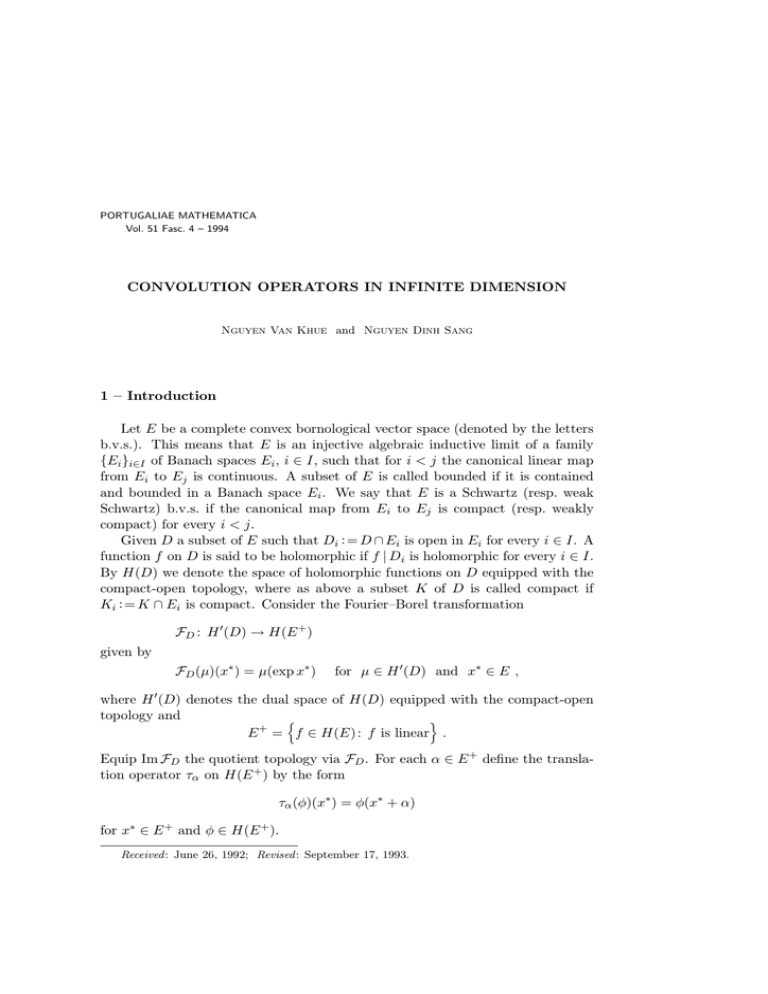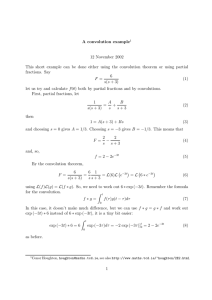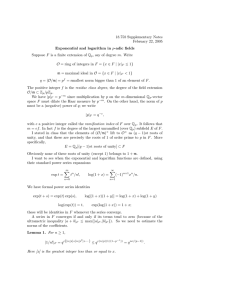CONVOLUTION OPERATORS IN INFINITE DIMENSION 1 – Introduction
advertisement

PORTUGALIAE MATHEMATICA
Vol. 51 Fasc. 4 – 1994
CONVOLUTION OPERATORS IN INFINITE DIMENSION
Nguyen Van Khue and Nguyen Dinh Sang
1 – Introduction
Let E be a complete convex bornological vector space (denoted by the letters
b.v.s.). This means that E is an injective algebraic inductive limit of a family
{Ei }i∈I of Banach spaces Ei , i ∈ I, such that for i < j the canonical linear map
from Ei to Ej is continuous. A subset of E is called bounded if it is contained
and bounded in a Banach space Ei . We say that E is a Schwartz (resp. weak
Schwartz) b.v.s. if the canonical map from Ei to Ej is compact (resp. weakly
compact) for every i < j.
Given D a subset of E such that Di : = D ∩ Ei is open in Ei for every i ∈ I. A
function f on D is said to be holomorphic if f | Di is holomorphic for every i ∈ I.
By H(D) we denote the space of holomorphic functions on D equipped with the
compact-open topology, where as above a subset K of D is called compact if
Ki : = K ∩ Ei is compact. Consider the Fourier–Borel transformation
FD : H 0 (D) → H(E + )
given by
FD (µ)(x∗ ) = µ(exp x∗ )
for µ ∈ H 0 (D) and x∗ ∈ E ,
where H 0 (D) denotes the dual space of H(D) equipped with the compact-open
topology and
n
o
E + = f ∈ H(E) : f is linear .
Equip Im FD the quotient topology via FD . For each α ∈ E + define the translation operator τα on H(E + ) by the form
τα (φ)(x∗ ) = φ(x∗ + α)
for x∗ ∈ E + and φ ∈ H(E + ).
Received : June 26, 1992; Revised : September 17, 1993.
588
NGUYEN VAN KHUE and NGUYEN DINH SANG
Since
FD τeα = τα FD ,
where τeα : H 0 (D) → H 0 (D) given by
(τeα µ)(ϕ) = µ(ϕ exp α)
for ϕ ∈ H(D) and µ ∈ H 0 (D), it follows that
τα : Im FD → Im FD
is continuous.
Now a continuous linear map θ : Im FD → Im FD is called a convolution
operator if it commutes with every translation.
2 – Statement of the results
In this note we always assume that E is a b.v.s. which is separated by E + and
D is a subset of E such that D ∩ Ei is connected and open in Ei for every i ∈ I.
Existence Theorem.
surjective.
Every non-zero convolution operator on Im FD is
Approximation Theorem. Let hold one of the following two conditions
i) D is balanced;
ii) D is polynomially convex and E is a weak Schwartz b.v.s. such that every
Ei has the approximation property.
Then every solution u of the homogeneous equation θu = 0 is a limit for the
topology of Im FD of solutions in P(E) Exp(D), where P(E) denotes the set of
all continuous polynomials on E and Exp(D) = span{exp(x) : x ∈ D}.
In the case E is a Schwartz b.v.s. such that every space Ei has the approximation property and D is a balanced convex open subset of E the above results have
established by Colombeau and Perrot [3]. Some particular cases were proved by
Boland [1], Dwyer [4], [5], [6] and Gupta [8].
3 – Proof
Let T ∈ (Im FD )0 , the dual space of Im FD , equipped with the strong topology,
and let T ∗ : Im FD → Im FD given by the form
(T ∗ φ)(α) = T (τα φ)
for φ ∈ Im FD and α ∈ E + .
CONVOLUTION OPERATORS IN INFINITE DIMENSION
589
Lemma 1. T ∗ is a convolution operator on Im FD and conversely each
convolution operator on Im FD is a T ∗ for some T .
0 : (Im F )0 → H 00 (D) = H(D) (algebraically).
Proof: First observe that FD
D
Define the continuous linear map UT from H 0 (D) to H 0 (D) by
0
UT (µ)(ψ) = µ(FD
(T ) ψ)
for µ ∈ H 0 (D) and ψ ∈ H(D).
We have
(T ∗ FD )(µ)(α) = (T ∗ FD (µ))(α) = T (τα FD (µ))
0
(T )(τeα (µ))
= T (FD τeα (µ)) = FD
0
= µ(FD
(T ) exp α) = (FD UT (µ))(α)
for all µ ∈ H 0 (D) and α ∈ E + .
Thus
T ∗ F D = F D UT .
This yields the continuity of T ∗ .
Let M denote the algebra of all convolution operators on Im FD and let γ be
the map from M to (Im FD )0 given by
γ : θ 7→ (φ 7→ θ φ (0)) .
It is easy to see that
γ(T ∗ ) = T
and
(γθ)∗ = θ .
Hence the map T 7→ T ∗ is a bijection between (Im FD )0 and M.
Lemma 2. Let F be a Fréchet space and let C(F ) denote the set consisting
of all compact balanced convex subsets of F . Then for every K ∈ C(F ) there
exists L ∈ C(F ) such that the canonical map from the canonical Banach space
F (K) spanned by K to F (L) is compact.
Proof: Let H be a closed separated subspace of F containing K. From a
result of Geijler [7] we can find a continuous linear map η from a Fréchet–Montel
space Q onto H. Since K is compact in H there exists B ∈ C(Q) such that
η(B) = K. Observe that the map ηe : Q(B) → F (K) induced by η is open. Thus
e ∈ C(Q) such that B ≤ B
e and the canonical
it suffices to show that there exists B
e from Q(B) to Q(B)
e is compact.
map e(B, B)
Let {k · kn } be an increasing sequence of continuous semi-norms defining the
topology of Q and let Qn be the canonical Banach space associated to k·kn . Since
590
NGUYEN VAN KHUE and NGUYEN DINH SANG
L
Q is reflexive, Q0 is bornological [10]. Hence Q0 = lim ind Q0n . Put P = n≥1 Q0n .
Let α be the canonical map from P onto Q0 .
e : Pρ →
First we find a continuous semi-norm ρ on P such that the map α
Q0p(K) induced by α is compact, where p(K) denotes the sup-norm on B. Take a
P
sequence λj ↓ 0 such that j λj ≤ 1 and such that for the unit open ball Uj in
Qj we have λj B ⊆ Uj . Consider the semi-norm ρ on P given by
ρ({uj }) =
X
kuj kj /λ2j ,
j
where uj ∈ Q0j and k · kj is the sup-norm on Uj .
e from Pρ to Q0p(B) .
Obviously α induces a continuous linear map α
e is compact.
We show that α
(n)
Indeed let {u } be a sequence in P such that
M = sup{ρ(u(n) ) : n ≥ 1} < ∞ .
Then for every m ≥ 1 and for every x ∈ B we have
X
(n)
|uj (x)| =
X
(n)
λj |uj (λj x)|/λ2j ≤ M
λj
j≥m
j≥m
j≥m
X
and
(n)
sup{kuj kj : n ≥ 1} ≤ M λ2j
for every j ≥ 1 .
(n)
e j )} is equicontinuous on B. Since B is comThese inequalities show that {α(u
(n)
pact it follows that {u } is relatively compact in Q0p(B) .
e ∈ C(Q) containing B such
Now by the openness of α : P → Q0 there exists B
that the canonical map induced by α from Pρ onto Q0p(B) is open. Hence the
canonical map from Q0 e to Q0p(B) is compact. This yields from the commutap(B)
tivity of the diagram
Q(B) −→ Q(B)
∩
∩
↓
↓
[Q0p(B) ]0 −→ [Q0p(B) ]0
0
e ,→ [Q0
in which the maps Q(B) ,→ [Q0p(B) ]0 and Q(B)
e ] are canonical embedp(B)
e
dings, the compactness of e(B, B).
Lemma 3. Let θ be a non-zero convolution operator on Im FD . Then UT
with T = γ θ, is surjective.
Proof: i) Let ψ ∈ H(D) with UT0 (ψ) = 0. Then
0
µ(FD
(T ) ψ) = (UT0 µ)(ψ) = 0
CONVOLUTION OPERATORS IN INFINITE DIMENSION
591
for every µ ∈ H 0 (D).
0 (T ) ψ = 0. Since F 0 (T ) 6= 0 it
By the Hahn–Banach Theorem we have FD
D
follows that ψ = 0. Thus UT0 is injective.
Assume now that {ψα } ⊂ Im UT0 which is weakly convergent to ϕ in H(D).
0 (T ) ψ | F ∩
Then for every finite dimensional subspace F of E, the sequence {FD
α
D} is weakly convergent to ϕ | F ∩ D. Since the ideal in H(F ∩ D) generated
0 (T ) | F ∩ D is weakly closed in H(F ∩ D) it follows that ϕ | F ∩ D =
by FD
0 (T ) |
FD
F ∩D ψF for some ψF ∈ H(F ∩ D). By the unique principle the family
0 (T )ψ = ϕ.
{ψF } defines a Gateaux holomorphic function ψ on D such that FD
This relation yields by the Zorn Theorem the holomorphicity of ψ on D. Hence
UT0 has the weakly closed image in H(D).
ii) Let φ ∈ H 0 (D) with UT (φ) 6= 0 and let µ be an arbitrary element of H 0 (D).
Take i0 ∈ I such that φ, µ ∈ H 0 (Di0 ). Let us note that the canonical map from
H 0 (Di0 ) to H 0 (D) induces a continuous linear map from Im FDi0 to Im FD for
which the following diagram is commutative
*
©
©©
UT
H 0 (D)
H 0 (Di0 )
FD
- H 0 (Di )
0
?
(1)
F Di
0
T∗
Im FD
*
©
©
?©©
Im FDi0
T0∗
- H 0 (D)
*
©
©
©
FD
?
- Im FD
*
©
F Di
?
©©
0
©
- Im FD
i0
where T0 ∈ (Im FDi0 )0 is induced by T .
Hence by Lemma 2 without loss of generality we may assume that E is a
Schwartz b.v.s. Take a strictly increasing sequence {ij }j≥0 in I. Put
F = lim ind Eij ,
D0 = D ∩ F
and
T0 = T | Im FD0 .
Consider the commutative diagram (1) in which Di0 is replaced by D0 with
φ, µ ∈ H 0 (Di0 ). By i) UT0 0 is injective and has the weakly closed image. This
implies that UT0 = UT000 is surjective. Thus µ = UT (β) for some β ∈ H 0 (D).
Proof of Existence Theorem: By the relation T ∗ FD = FD UT we infer
that Existence Theorem is an immediate consequence of Lemma 3.
To prove Approximation Theorem we need the following five lemmas.
Lemma 4. Exp(D) is dense in Im FD .
592
NGUYEN VAN KHUE and NGUYEN DINH SANG
Proof: Let S ∈ (Im FD )0 such that S(exp x) = 0 for every x ∈ D.
Then
0
FD
(S)(x) = 0 for every x ∈ D .
0 is injective, it follows that S = 0.
Since FD
Lemma 5. Let f, g ∈ H(D) such that for every finite dimensional subspace
F of E on which g 6= 0, the function f | F ∩ D is divisible by g | F ∩ D. Then f
is divisible by g.
Proof: By the unique principle there exists a Gateaux holomorphic function
h on D such that f = h g. Since h is holomorphic at every x ∈ D with g(x) 6= 0,
by the Zorn Theorem h is holomorphic on D.
Lemma 6. Let X, T ∈ (Im FD )0 , T 6= 0, such that
T ∗ P exp(x) = 0 ⇒ X(P exp(x)) = 0 .
∀ x ∈ D, ∀ P ∈ P(E) :
0 (X) is divisible by F 0 (T ).
Then FD
D
Proof: By hypothesis we have
∀x ∈ D:
0
0
FD
(T )(x) = 0 ⇒ FD
(X)(x) = 0 .
0 (X) | F ∩ D is divisible by F 0 (T ) | F ∩ D for every finite
This implies that FD
D
0 (T ) 6= 0. Lemma 5 yields that F 0 (X)
dimensional subspace F of E on which FD
D
0 (T ).
is divisible by FD
Lemma 7. Let E be a weak Schwartz b.v.s. and let i < j < k. Then E + is
dense in Ek0 | Ei .
Proof: Denote by Ei+ the completion of E + / Ker k · ki , where k · ki is the
semi-norm on E + defined by the unit open ball Ui in Ei . Since E + separates the
points of E, it follows that E + ⊆ lim ind Ei+ (algebraically). On the other hand,
by the weak compactness of the canonical map ωij from Ei to Ej for every i < j
and since Ui is σ(Ei+0 , Ei+ )-dense in the unit open ball Ui+0 in Ei+0 we have
+0
+0
+0
Cl ωij
(Ui+0 ) = Cl ωij
(Clσ(E +0 ,E + ) Ui ) ≤ Clσ(E +0 ,E + ) ωij
(Ui ) = Cl ωij (Ui ) ≤ Ej ,
i
i
+
ωij
j
Ej+
j
where
is the restriction map from
to
and Ui+ is the unit open in Ei+ .
+
Thus for i < j < k we have by the weak compactness of ωij
the following two
commutative diagrams
Ej −→ Ej+0
+0
ωjk |
. | ωjk
+0
Ek −→ Ek
Ei+
Ej+ −→ Ej+
+
|
. | ωij+00
ωjk
+
Ei −→ Ei+
593
CONVOLUTION OPERATORS IN INFINITE DIMENSION
This implies that E + is dense in Ek0 | Ei .
Put
n
H0 (D) = f ∈ H(D) : D n f (x) can be approximated
o
by elements of E ⊗n for every x ∈ D .
Lemma 8. Ker FD = [H0 (D)]⊥ and hence Im FD ⊆ H0 (D).
Proof: Let µ ∈ [H0 (D)]⊥ . Then
(FD µ)(x∗ ) = µ(exp x∗ ) =
X
k
(1/k!) µ(x∗ ) = 0
k≥0
for every x∗ ∈ E + .
Hence µ ∈ Ker FD . Conversely, assume that FD µ = 0. By hypothesis on D
and on E it follows that H0 (E) is dense in H0 (D).
Proof of Approximation Theorem:
If θ = 0, the result is true
since P(E) Exp(D) is dense in Im FD . Let θ 6= 0 and let X ∈ (Im FD )0 ,
X | P(E) Exp(D) ∩ Ker θ = 0. This means that
∀ P ∈ P(E), ∀ x ∈ D :
T ∗ P exp(x) = 0 ⇒ X(P exp(x)) = 0
where T ∗ = θ.
0 (X) = h F 0 (T ) for some h ∈ H(D). From the
Lemma 6 implies that FD
D
0 (X) ∈ H (D) and F 0 (T ) ∈ H (D), it is easy to see that
relations FD
0
0
D
0 (Q) for some Q ∈ (Im F )0 . Hence
h ∈ H0 (D) = (Ker FD )⊥ . Thus h = FD
D
0 (X) = F 0 (Q) F 0 (T ) = F 0 (Q∗ T ). From the injectivity of F 0 we have
FD
D
D
D
D
X = Q∗ T = T ∗ Q = (T ∗ )0 Q = θ0 (Q) .
These equalities imply X = 0 on Ker θ.
REFERENCES
[1] Boland, P.J. – Malgrange Theorem for entire functions on nuclear spaces, Lecture
Notes in Math., 364 (1974), 135–144.
[2] Colombeau, J.F. and Perrot, B. – Transformation de Fourier–Borel et noyeaux
en dimension infinie, C.R. Acad. Sci. Paris. Ser. A, 284 (1977), 963–966.
[3] Colombeau, J.F. and Perrot, B. – Convolution equation in spaces of infinite
dimensional entire functions of exponential and related types, Trans. Amer. Math.
Soc., 258 (1980), 191–198.
594
NGUYEN VAN KHUE and NGUYEN DINH SANG
[4] Dwyer, T.A.W. – Equations differentielles d’ordre infinie dans des localement
convexes, C.R. Acad. Sci. Paris. Ser. A, 218 (1975), 163–166.
[5] Dwyer, T.A.W. – Differential operators of infinite order on locally convex spaces
I, Rend. Math., 10 (1977), 149–179.
[6] Dwyer, T.A.W. – Differential operators of infinite order on locally convex spaces
II, Rend. Math., 10 (1978), 273–293.
[7] Geijler, W. – Extending and lifting continuous linear mappings in topological
vector spaces, Studia Math., 62 (1978), 295–303.
[8] Gupta, C. – Malgrange Theorem for nuclear entire functions of bounded type on
a Banach space, Idag. Math., 32 (1970), 356–358.
[9] Noverraz, Ph. – Pseudo-Convexite, Convexite Polynomiale et Domaines d’Holomorphie en Dimension Infinie, North-Holland Math. Stud., 3, 1973.
[10] Schaefer, H. – Topological Vector Spaces, Springer-Verlag, 1971.
Nguyen Van Khue and Nguyen Dinh Sang,
Department of Mathematics, Pedagogical Institute Hanoi I,
Hanoi – VIETNAM







